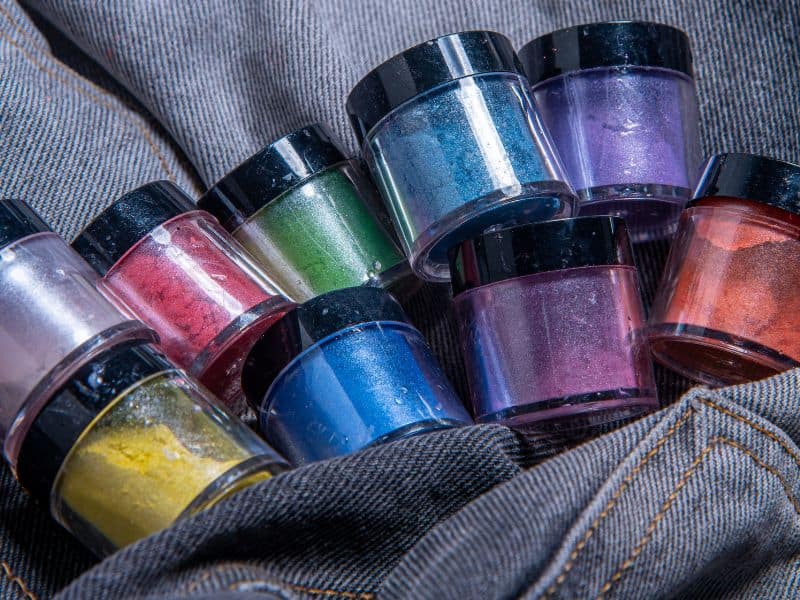Soap making is an art form that has been gaining popularity in recent years. It’s a great way to experiment with new techniques and ingredients while creating something unique and special. Mica powder is one of the ingredients often used in soap making, but it can sometimes be confusing to understand how it works. Let’s take a look at what mica powder is and how you can use it in your own soap-making journey.
Add up to ½ teaspoon of mica powder per pound of base oils. To ensure the color blends in quickly and evenly, first mix 1 teaspoon of mica with 1 tablespoon of 99% isopropyl alcohol. Then, add ¼ teaspoon of the resulting mixture to the melted soap until you reach the desired hue.
The color can change slightly after the soap cures and hardens so this is something you might want to play around with in small batches until you get exactly the color that you want in the finished product. Let’s take a closer look at the use of mica when making soap.
What Exactly is Mica Powder?
Mica powder is a naturally occurring mineral composed of silicates. When used as a colorant for soap making, mica powder adds shimmer and sparkle. This mineral has many benefits when used in soap making including being gentle on the skin and providing vibrant color without using synthetic dyes or harsh chemicals. It also won’t fade or bleed over time as artificial dyes can.
Mica powder comes in a variety of colors and can be mixed together to create custom hues. The finer the mica powder, the better its color payoff will be. Generally speaking, the more finely milled mica you use in your soap recipes, the brighter the final product will be after curing.
How To Add Mica Powder To Cold Process Soap
When using mica powder in a cold process soap recipe, you want to add the mica after the cook and during the trace stage. The mica is added at this stage because it will disperse evenly throughout the soap as it’s being mixed.
Disperse the mica in an oil such as almond oil, glycerin, or isopropyl alcohol. Mix 1 teaspoon of mica with 1 tablespoon of oil until it is completely blended together and free of clumps. Add the mixture to your soap slowly, about 1 teaspoon at a time, until your desired color is achieved.
You may need to experiment a bit with different mica colors and mixtures to achieve your desired hue. Using mica powder in soap making is simple once you understand the basics. With just a few ingredients, you can create beautiful and unique soaps that will add a touch of sparkle and shine to your home.
Benefits of Using Mica Powder in Soap Making
Using mica powder to color soaps offers several advantages over using synthetic dyes or other colorants such as activated charcoal or botanicals like rose clay or pink salt:
- Adds a subtle shimmer without looking too “sparkly”.
- Long lasting – does not fade easily.
- Non-toxic – no need to worry about potential dye allergies.
- Easy to use – mica powder can be mixed in directly with the base oils without having to make a separate solution.
- Versatile – mica powder can be used to create a wide range of colors.
Steps to Add Mica Powder in Soap Making
When adding mica powder to your soap-making process there are several steps you should take:
Melting the Base Oils/Butters
First, you’ll need to melt down any solid oils/butters you’re using (such as shea butter). Be sure not to overheat them!
Mixing the Colorant into the Oil
Once melted, mix your chosen mica powder into the oil (or directly into melted butter). Stir well until completely blended then add your fragrance oil of choice (optional) for added scent.
Adding Fragrance Oils
Add any desired essential oils or fragrance oils at this point if desired for extra scent before pouring into mold(s).
Pouring the Soap into the Mold
Now pour your colored mixture into mold(s), taking care not to disturb it too much otherwise some separation may occur which could change its look when cured later (this same rule applies equally even if using liquid dyes instead). Allow soaps ample time to cure before cutting or packaging for sale/gifting!
Tips for Working with Mica Powder
When working with mica powder, here are a few tips to remember:
Always wear safety glasses when handling mica powder
Take care when handling mica powder because it can cause issues if it is inhaled or gets in your eyes. Use safety glasses and even a mask if you have a respiratory condition and are worried about adverse results.
Be sure to use mica powder that is approved for cosmetic use
Use mica powder that is approved for cosmetic use. You do not want to use mica powder that is not approved in soaps that people will use on their bodies.
Start off slowly by mixing small amounts
Start off slow and add in the mica powder slowly, mixing it together until you see the desired shades & tones. You may need to experiment with a few different types of mica powder to get the desired results.
Test each mix on white scrap paper first
Test your colors on some white scrap paper first. You will get to see the color and then get an idea about what the finished product might look like. this helps save time & trouble if things don’t turn out right!
Frequently Asked Questions
Yes, mica powder is a safe and natural way to color your soaps. It is non-toxic and approved for cosmetic use, so it is safe to use in soaps that people will use on their bodies.
Mica powders are very long-lasting and do not easily fade. However, mica colors can change slightly over time depending on the type of mica powder used and what other ingredients are mixed in with it.
Yes, mica powder is hypoallergenic and does not contain any known allergens. If you are worried about potential allergies, mica powder is a great choice for coloring your soap. Additionally, mica powders can usually be mixed in directly with the base oils without having to make a separate solution. This helps reduce the possibility of skin irritation.
Yes, mica powder is safe to use in soaps for kids. However, be sure to check the mica powder you are using is approved for cosmetic use before adding it to your soap. Additionally, mica powder can often be mixed directly with the base oils without having to make a separate solution, which can help avoid skin irritation.
Conclusion
Mica powder is an easy-to-use ingredient for those looking for vibrant colors without having to use harsh artificial dyes or toxins that could irritate the skin upon contact with lye solution during soap cure periods after pouring into mold(s). Knowing how it works properly will help ensure success when crafting beautiful handmade artisan soaps!






